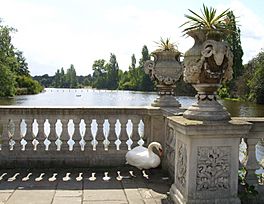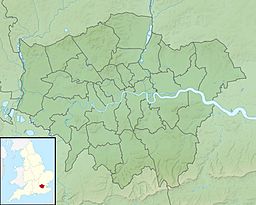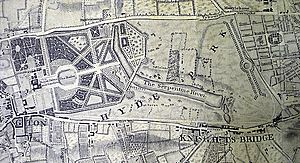The Long Water facts for kids
Quick facts for kids The Long Water |
|
|---|---|

The Long Water from the Italian Garden
|
|
| Location | London, England |
| Coordinates | 51°30′27″N 0°10′28″W / 51.507378°N 0.174444°W |
| Type | Artificial lake |
| Primary inflows | Three boreholes from the upper chalk |
| Primary outflows | Storm Relief Sewer |
| Basin countries | England |
The Long Water is a fun lake in Kensington Gardens, London, England. It was made in 1730 for Queen Caroline. It's the long, narrow western part of a bigger lake called the Serpentine. The Serpentine Bridge separates it from Hyde Park and marks its eastern edge.
People usually think of the Long Water and the Serpentine as one big lake.
Contents
Where is the Long Water?
Originally, the lake got its water from the River Westbourne. This river flowed into the lake at the Italian Garden, which is at the north-western end of the Long Water.
However, the River Westbourne became dirty. So, in 1834, it stopped supplying water to the Serpentine. After that, water was pumped from the Thames.
How the Lake Gets Water Now
Today, the lake gets its water from three special wells called boreholes. These wells are drilled deep into the ground, into something called the Upper Chalk.
- The first borehole is at the Italian Gardens.
- The second is near the Diana Memorial.
- The third was drilled in 2012. It goes down 132 meters (about 433 feet) and is also close to the Diana Memorial.
The Long Water flows south-east from the Italian Garden area. It reaches the Serpentine Bridge, where the lake then curves to the east. This curve follows the natural shape of the land.
Water Flow and Waterfalls
At the eastern end of the lake, water flows out through a gate called a sluice. This creates a small, pretty waterfall at a spot called the Dell. In the past, this waterfall didn't always have enough water. So, pumps were put in place to keep it flowing.
In 2012, restoration work helped bring back the original water flow into the Serpentine. Now, the waterfall at the Dell works just as it was first designed.
Historically, the River Westbourne flowed south from this point. It used to mark the border between Westminster and Kensington. But since 1850, the river has been moved into an underground pipe. It now runs hidden underground until it reaches the Thames near Chelsea Bridge.
How Deep is the Lake?
The entire lake, including the Serpentine part, is about 17 feet (5.3 meters) deep at its deepest point. People often think it's deeper. But special surveys done by the Royal Park in 2010 showed its true depth.
History of the Long Water
In 1730, Queen Caroline was the wife of King George II. She ordered a big project to improve Hyde Park and Kensington Gardens. As part of this, she had the River Westbourne blocked in Hyde Park.
There might have been old ponds from monasteries in this area before. These were changed as part of the 1730–1732 plan to create one large lake. At that time, the Westbourne River formed eleven natural ponds in the park. During the 1730s, the lake filled up to its current size and shape.
Designing a Natural-Looking Lake
The Royal Gardener, Charles Bridgeman, led this project. He blocked the Westbourne to create the artificial lake. He also dug a large pond in the middle of Kensington Gardens, called The Round Pond. This pond became a central point for paths in the park.
When artificial lakes were first built, they were usually long and straight. The Serpentine was one of the first artificial lakes made to look natural. Its design was copied by many other parks and gardens across the country.
Big Events at the Lake
The lake was a main spot for celebrations in 1814. These events marked 100 years of the Hanoverian royal family. They also re-enacted the British victory at the Battle of Trafalgar from nine years before.
The lake was also important for the Great Exhibition in 1851. The famous Crystal Palace building stood on its southern shore during this event.
Later, rules were made to protect the park's environment. The Crystal Palace was moved, and new museums were built nearby. Because of this, big events stopped happening on the banks of the Serpentine.
However, the lake was used for the 1977 Silver Jubilee celebrations. It was also a venue for the 2012 Olympics.
Dividing the Lake
In the 1820s, the park was redesigned by Decimus Burton. At the same time, John Rennie built the Serpentine Bridge. This bridge was made to carry the new West Carriage Drive. It also divided the lake into two parts: the Serpentine (to the east) and the Long Water (to the west).
What's Around the Long Water?
At the northern end of the Long Water, you'll find the Italian Gardens. This area has five fountains and beautiful classical statues. There's a large bronze memorial here for Edward Jenner. He developed modern vaccination, which helps protect people from diseases. This statue was first in Trafalgar Square in 1858. Four years later, it was moved to its current spot. Some people have been trying to get the memorial moved back to Trafalgar Square.
A Home for Wildlife
The Long Water is a special place for birds. It's a bird sanctuary. Many different kinds of waterfowl live and breed here. In winter, lots of birds that migrate also visit. A survey in 2005 found that 90 different kinds of moths live here alone!
On the western bank of the Long Water, hidden among the trees, is a bronze Peter Pan statue. It was made by George Frampton. The stories of Peter Pan are set in this park and the nearby streets.
Images for kids
-
The brutalist architecture of the Dell Restaurant, situated on the northern end of the dam, dominates the eastern end of the lake.
-
Cormorants fishing from posts in the Long Water
-
The Solarshuttle, moored in front of Hyde Park Barracks
















